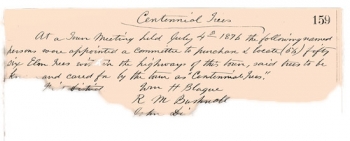
On July 4, 1876, eight citizens of Old Saybrook held a town meeting to declare they would plant 56 American elms in honor of the 56 signers of the Declaration of Independence. “Said trees [are] to be known and cared for by the town as the Centennial Trees,” the clerk recorded in Volume 8, page 159 of the records book that resides today at the Town Clerk’s office.
So began the story of Old Saybrook's Centennial elms. The town was not alone; New Haven and villages all over the emerging nation undertook the same project.
One hundred forty-two years stand between us and the patriotic gesture of that Centennial Tree committee. Dutch Elm Disease, the Hurricane of 1938, and other challenges took most of the trees. Miraculously, five are survivors. We know because the Centennial planters carefully noted the exact locations of their saplings in Volume 8, page 159.
Some ask: Should we aim to recreate the leafy cathedrals of old? It’s tempting, because, finally, disease-resistant elms have come into their own. But the trees are only part of the formula. Village density, embedded structures, and utility poles make this idea all but impossible in today’s world. New elm cathedrals are best created in parks, if anywhere. The elms taught us that when we concentrate one species in an area, they can succumb en masse when new threats arrive.
Today, most arborists would recommend planting multiple species—but we can still choose tall trees. Here are some ideas:
- American elms, disease-resistant: ‘Princeton,’ ‘Valley Forge,’ ‘Pioneer,’ and ‘Liberty’.
- Pin oaks, Quercus palustris
- Red oaks, Quercus rubra
- Scarlet oaks, Quercus coccinea
- American lindens, Tilia americana
- Little Leaf lindens, Tilia cordata
- American sycamores, Platanus occidentalis
